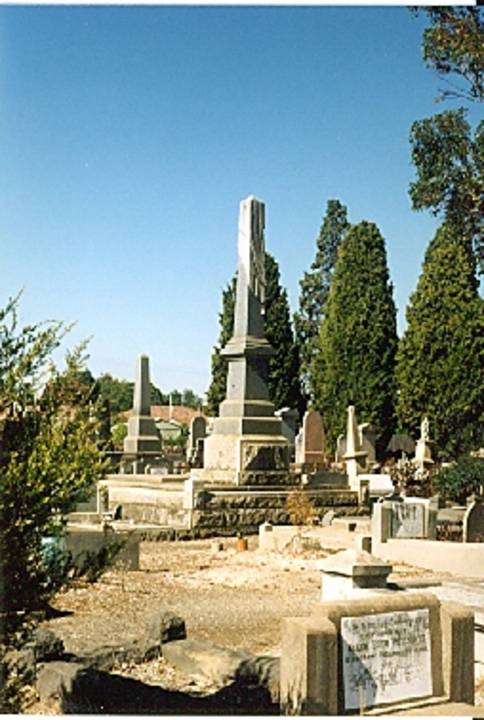| Back to search results » | Back to search page » |
|
Western Cemetery
LocationMinerva Road, HERNE HILL VIC 3218 - Property No B6816
File NumberB6816LevelState |
|
Statement of Significance
The Geelong Western Cemetery is a provincial cemetery dating from the mid-1850s which retains its nineteenth century character and has been in continual use throughout that period. Twentieth century additions, such as the outstanding avenue of Italian Cypress trees, add to the character and reinforce the cemetery's sense of enclusure. The Geelong Western Cemetery is of State significance for the following reasons:
- its importance in the course of Australia's cultural history as a sophisticated and substantially intact example of a large, mid nineteenth century provincial cemetery.
* It exhibits unusual cultural features associated with the development of mid nineteenth century provincial cemeteries.
- its possesseion of uncommon aspects of Australia's cultural history as a large, mid nineteenth century provincial cemetery.
* Its importance in demonstrating a distinctive way of life, custom, and design no longer practised and in danger of being lost. It is of exceptional interest as most large, mid nineteenth century provincial cemeteries no longer demonstrate their characteristic design as twentieth century overcrowding and neglect have generally resulted in the loss of earlier schemes.
- its potential to yield information that will contribute to an understanding of Australia's cultural history.
* Its importance for information contributing to a wider understanding of Australian history, by virtue of its use as a research and reference site.
* Its importance for information contributing to a wider understanding of the history of human occupation of Australia. For example by providing information about the patterns of deaths in the provincial city of Geelong by age, religion and family; and sometimes giving causes, occupations and other information. By illustrating the importance of homelands in epitaphs and also by demonstrating the range of technical and craft skills and materials available.
* for its collection of trees ftom the nineteenth century, including three large elms (Ulmus species), a Canary Island Pine (Pinus canariensis), a fine specimen of Southern Magnolia (Magnolia grandiflora), an uncommon Norway Spruce (Picea Abies) and the shrub Common Myrtle (Myrtus communis). Also for its collection of trees planted in the first decades of the twentieth century, consisting of Italian Cypress (Cupressus sempervirens) and Bhutan Cyupress (C.torulosa) which were used to define the gravel pathways. These are perhaps the finest planting of Italian Cypress in a Victorian cemetery.
* For its value as a historical record, a collection of individual memorials, its continuity and security, for the manner in which it inspires a respect for the dead, as a social document, and for its role in education and recreation.
- its importance in demonstrating the principal characteristics of: (1) A class of Australia's cultural places, being large, mid nineteenth century provincial cemeteries.
* Its importance in demonstrating the principal attributes which are characteristic of the class. These are: the road and path layout with distinct compartments and view lines despite the flat site which are reinforcerd by looped pathways, boundary and accent plantings.
* Its importance in demonstrating the principal characteristics of the range of human activities in the Australian environment (including way of life, custom, process, land use, function, design or technique). It demonstrates the Victorian view of cemeteries as public parks which was respected and further highlighted by the 1920s plantings of Italian Cypress.
- its importance in exhibiting mid nineteenth century cemetery characteristics valued by the communtiy of the provincial city of Geelong.
* Its importance to the community for aesthetic characteristics held in high esteem is demonstrated in the value of the cemetery as a public park, the vistas and views within the cemetery, and also in that twentieth century development respected the earlier design.
- its importance in demonstrating a high degree of creative or technical achievement of the mid nineteenth century period with the overlay of significant early twentieth century avenue plantings.
* importance for technical, creative, design or atristic excellence, innovation or achievement, including monuments of state significance such as the Strachan Mausoleum and the cemetery's collection of memorials, tombstones and other funerary art.
- its strong or special associations with a particular community or cultural group for social, cultural or spiritual resons.
* Its importance as a place highly valued by a community for reasons of religious, spiritual, symbolic, cultural, educational and social associations. Geelong Western Cemetery has special associations with the working class Geelong West community but is also of importance to post war migrants with family monuments at the cemetery.
- its pecial association with the life or works of a person, or group of persons, of importance in Australia's natural or cultural history.
* Its importance for close associations with individuals whose activities have been significant within the history of the State or region and are illustrated in the monuments and epitaphs to them, including King Dan Dan Nook (Jerry) and other members of the Barrabool Tribe and the Hon. James Strachan. It is very rare for a monument to Aborigines to be funded by the white community.
Classified: 04/08/1997
Group
Cemeteries and Burial Sites
Category
Cemetery/Graveyard/Burial Ground




